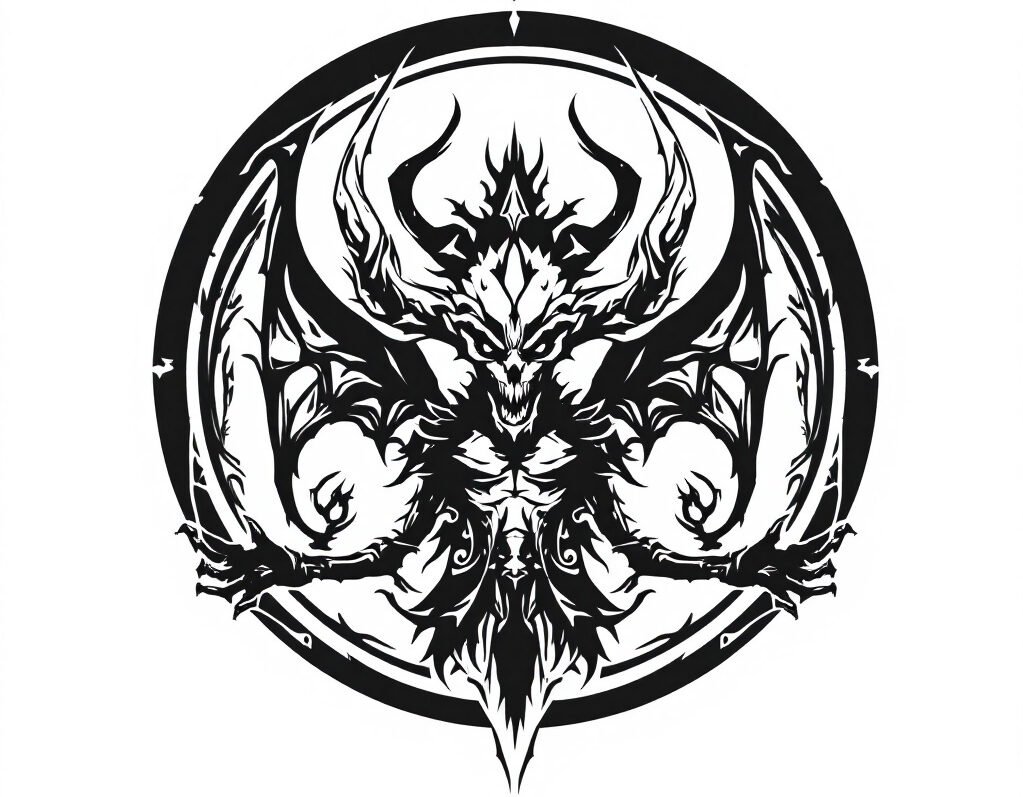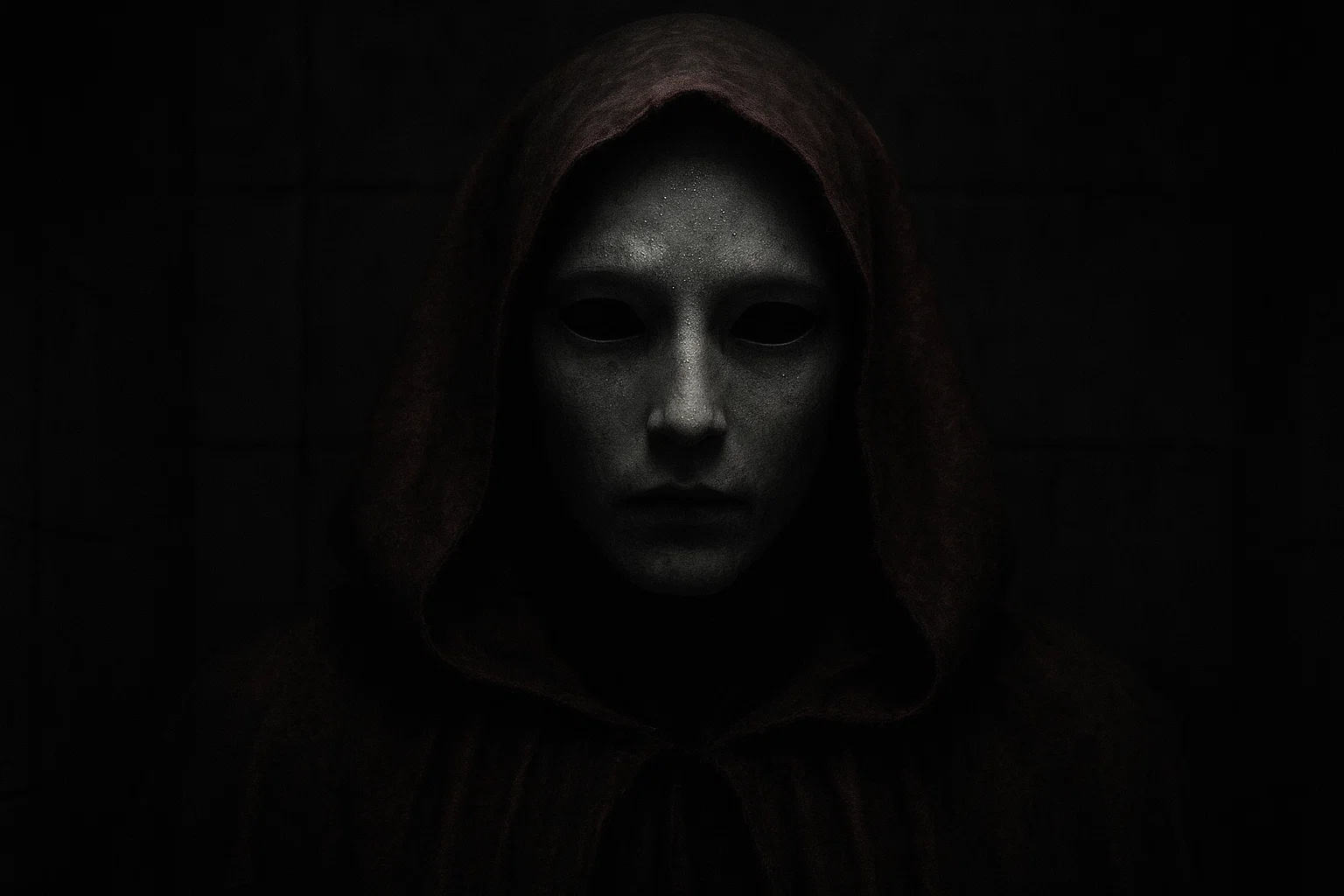Aka Manto is a malevolent yūrei known for haunting bathrooms—particularly in schools—where it presents its unsuspecting victims with a deadly choice.
This entity, often depicted as a masked or cloaked man, confronts individuals in secluded stalls, offering a choice between red and blue—cloaks, paper, or capes, depending on the tale—with fatal consequences tied to each option.
Unlike traditional yōkai (such as tengu or kappa), which are typically linked to Shinto or Buddhist cosmologies, Aka Manto emerged in the 1930s as a product of 20th-century Japanese urban folklore.
Summary
Key Takeaways
| Attribute | Details |
|---|---|
| Names | Aka Manto, Ao Manto, Akai Manto, Red Cape, Blue Cape |
| Translation | “Red Cloak” or “Red Cape”; aka (red) and manto (cloak/cape) |
| Title | Bathroom Spirit, Red-Cloaked Ghost |
| Type | Yūrei (ghostly spirit) |
| Origin | Modern urban legend, likely emerging in the 1930s during Japan’s Showa era, tied to school bathroom hauntings |
| Gender | Ambiguous, often described as male but sometimes unspecified |
| Appearance | A shadowy figure wearing a red cloak or cape, often with a masked or featureless face; sometimes depicted with a hood or scarf obscuring features |
| Powers/Abilities | Ability to materialize in bathrooms, present victims with a choice (red or blue), and kill based on their answer; possibly shapeshifting or teleportation |
| Weaknesses | Avoiding answering the question, remaining silent, or fleeing the bathroom; some tales suggest specific phrases or actions (e.g., choosing a third color) can confuse it |
| Habitat | Public restrooms, especially school bathrooms, often the last stall |
| Diet/Prey | Targets lone individuals, particularly children or students, in bathrooms |
| Symbolic Item | Red or blue cloak/cape, sometimes toilet paper |
| Symbolism | Represents fear of isolation, decision-making under pressure, and vulnerability in private spaces |
| Sources | Modern urban legends, oral traditions, and pop culture; no classical texts like Kojiki or Nihon Shoki mention Aka Manto |
Who or What is Aka Manto?
Aka Manto (or “Red Cloak,” “Red Cape,” “Red Vest,” “Akai-Kami-Aoi-Kami”) is a very dangerous yūrei (a type of yōkai) that allegedly haunts Japanese school bathrooms, targeting children who are alone. According to the urban legend, the spirit appears in the last stall of a restroom, asking its victim to choose between a red or blue cloak (or sometimes paper).
However, the choice is a trap: selecting red leads to being flayed or drenched in blood, while blue results in strangulation or suffocation.
Aka Manto’s origins are unclear, likely tied to Japan’s Showa-era (1926–1989) fascination with school-based horror stories, reflecting anxieties about privacy and unseen dangers in familiar spaces.
This yūrei, unlike ancient yōkai rooted in nature or mythology, thrives in modern settings, transforming the mundane act of using a restroom into a life-or-death gamble.
Aka’s gender is ambiguous—some tales depict a male figure, others leave it undefined. Its ability to materialize suddenly and force a fatal decision sets it apart from other yōkai, aligning it with urban spirits like Hanako-san, another bathroom-dwelling ghost.
You may also enjoy:
What Is the Abumi-guchi Yōkai and Why Does It Wait Forever?
October 22, 2025
Who Is Agares, the Demon of Earthquakes and Deception?
October 13, 2025
Who Is Aka Manto, Japan’s Terrifying Red-Cloaked Yōkai?
October 24, 2025
Si’la: The Seductive Jinn Who Lures Travelers to Their Doom
October 9, 2025
Who Was Hiranyakashipu, the Demon King of Hindu Mythology?
October 6, 2025
Who Was Hiranyaksha, the Golden-Eyed Asura?
October 7, 2025
Aka Manto Meaning
The name Aka Manto derives from Japanese, with aka (赤) meaning “red” and manto (マント) referring to a “cloak” or “cape,” a loanword from Spanish or Portuguese adopted during Japan’s Meiji era (1868–1912).
The term evokes a vivid image of a figure draped in a blood-red garment, a color tied to danger and death in Japanese culture. Variations like Ao Manto (“Blue Cloak”) may appear in some legends, reflecting the dual-choice motif central to the legend.
In certain regions, Akai Manto uses the native Japanese akai for “red,” emphasizing local linguistic nuances over the Westernized manto.
The name’s simplicity misrepresents its psychological weight. Since it’s a relatively new term, Aka Manto lacks the deep etymological roots of older yōkai like tengu (from Chinese tiangou, “heavenly dog”). Instead, its origins tie to urban folklore, possibly inspired by schoolyard rumors or moral panics about public restrooms as dangerous spaces.
In Tono Monogatari, the Japanese folklore compiler Kunio Yanagita suggests that the name reflects a blend of Western Gothic imagery (cloaked figures) and spiritual fears (with the red hinting at blood or sacrifice).
How to Pronounce Aka Manto in English
To pronounce Aka Manto in English, break it into syllables: Ah-kah Mahn-toh. The first part, Aka, has a short “a” sound like in “father,” followed by a crisp “ka.”
Manto stresses the first syllable, with “man” pronounced as in “manor” and “toh” like “toe.” The vowels are clear, without diphthongs, reflecting Japanese phonetics.
What Does Aka Manto Look Like?
Aka Manto’s exact physical appearance is actually shrouded in mystery, enhancing its terror. Most accounts describe a tall, shadowy figure cloaked in a vibrant red cape or hooded garment, often concealing its face with a mask, scarf, or unnatural darkness.
Some tales suggest a handsome male visage beneath the mask. In contrast, others depict a featureless void, amplifying the yōkai’s otherworldly dread.
The cloak’s color—vivid red—dominates descriptions, symbolizing blood or danger. However, variants mention a blue cloak (Ao Manto) in stories where the choice extends to both colors. Occasionally, Aka Manto is said to hold (or be covered in) red or blue toilet paper.
Unlike yōkai with animalistic or grotesque forms, Aka Manto’s humanoid shape is deceptively simple, lacking the exaggerated features of an oni or kappa. Its minimalistic design—focused on the cloak and obscured face—heightens its menace, as victims cannot read its intentions.
Habitat
Aka Manto lives in the liminal spaces of modern Japan—specifically, public restrooms—preferring school bathrooms. The last stall—often considered the most secluded—is its favored haunt, a detail consistent across urban legends.
This choice reflects the restroom’s role as a private, vulnerable space where individuals are alone and exposed. Schools, as settings filled with children and adolescents, amplify the yōkai’s threat, tapping into fears of predation in places meant to be safe.
Origins and History
Aka Manto first appeared in the 1930s, during Japan’s Showa era, a period marked by rapid modernization and social change. Unlike ancient yōkai (such as Oni or Kitsune) rooted in Shinto mythology or Heian-era texts, Aka Manto is a product of urban folklore, born from schoolyard rumors and societal anxieties.
Its earliest mentions appear in oral traditions, particularly among schoolchildren in urban centers like Tokyo. The yōkai likely reflects fears of strangers in newly crowded cities, with public restrooms—spaces of privacy amid public settings—becoming loci for supernatural dread.
The yōkai’s narrative may draw on older ghostly traditions, such as vengeful spirits (onryō). Still, its modern setting and lack of ties to specific historical figures set it apart.
Some folklorists link Aka Manto to moral panics about school safety, with its red-and-blue choice motif possibly inspired by Western Gothic tales of fatal decisions, adapted to Japanese sensibilities.
Over time, Aka Manto evolved through retellings in manga, anime, and horror films, cementing its place in pop culture. By the late 20th century, it joined other urban yōkai, such as Hanako-san.
Sources
Aka Manto does not appear in Kojiki, Nihon Shoki, Konjaku Monogatari, or other classical Japanese texts. As a modern urban legend, its origins lie in 20th-century oral traditions and pop culture rather than historical records.
Folklorist compilations, such as those by Kunio Yanagita or Shigeru Mizuki’s Yōkai Dictionaries, reference Aka Manto as a Showa-era creation, but no ancient sources document it.
Famous Aka Manto Legends and Stories
Red or Blue
In an urban legend from 1930s Tokyo, a young schoolgirl named Yumi stays late after club activities. The school was nearly empty, shadows lengthening as the sun dipped below the horizon, casting an orange glow through the frosted windows of the old wooden school.
Before heading home, Yumi goes to the third-floor bathroom—an outdated facility with squat toilets and peeling paint, rarely used since the newer wing was built. She chooses the last stall—the fourth one, with a bad reputation among students for being cursed with bad luck—its door creaking ominously on rusty hinges.
As Yumi finishes and reaches for the toilet paper dispenser, she finds it empty, the cardboard roll mocking her with its hollow rattle. A chill seeps through the air, thicker than the evening fog outside, and a low, velvety voice echoes from the shadows beyond the stall door:
“Red paper… or blue paper?”
Frozen, pants still around her ankles, Yumi’s mind races—rumors of Aka Manto have swirled for years, tales of girls who never returned from similar predicaments.
The voice repeats, closer now, insistent, like silk tearing slowly: “Red… or blue?” Trembling, she whispers “Red,” hoping it’s the safer choice.
The stall door bursts open with a crack like thunder, revealing a towering figure draped in a flowing red cloak that billows like fresh blood in the windless room. Beneath a stark white mask—featureless save for slits for eyes that gleam with unnatural hunger—stands Aka Manto, his form both handsome and decayed, skin pale as porcelain cracked by time.
In one gloved hand, he holds a sheaf of crimson paper; in the other, azure. But mercy is a lie. With a swift motion, ethereal blades unseen slice through the air, carving deep gashes across Yumi’s back and arms.
Blood sprays in arcs, soaking her uniform until it clings like a second skin, a grotesque parody of the red cloak he wears. She collapses, gasping, her final screams muffled by the porcelain bowl, as the spirit vanishes, leaving only crimson stains that no janitor would ever fully scrub away.
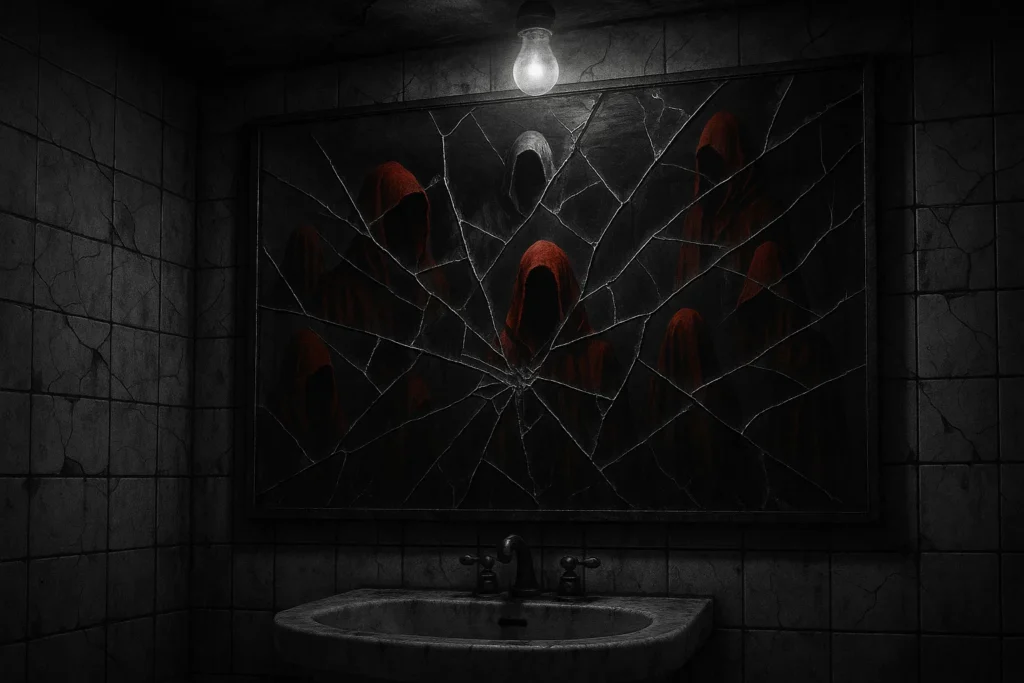
The Silent Escape
Hiroshi was a skeptical middle school boy known for debunking playground myths.
One rainy autumn evening, after detention for talking back to his teacher, Hiroshi ducks into the boys’ restroom on the ground floor. The storm outside rages, thunder rumbling like distant warnings. Still, inside, the only sound is his hurried footsteps splashing in shallow puddles near the sinks.
Washing his hands under the sputtering faucet, Hiroshi glances in the cracked mirror, catching a flicker of red in the periphery—a hooded silhouette materializing in the last stall, its cloak pooling like spilled ink on the wet floor.
The figure doesn’t knock or announce; it simply… is there, a presence that sucks the warmth from the room, frost creeping along the pipes.
A deep, resonant voice slithers from the shadows: “Red paper… or blue paper?” Hiroshi’s blood runs cold; he’d mocked the Aka Manto tales just that afternoon, calling them “baby stories for scared girls.”
The voice presses again, laced with impatience, the stall door rattling faintly as if claws scrape the wood from within: “Choose… red or blue?”
Hiroshi clamps his mouth shut, soap suds dripping from clenched fists, eyes fixed on the drain as if it might swallow him whole. He backs away slowly, sneakers squeaking on the tiles, refusing to engage, to give the spirit the verbal hook it craves.
“Answer me!” it demands, the mask’s slits flaring with crimson light. But Hiroshi bolts, bursting through the bathroom door into the hallway, rain-lashed windows framing his flight to the safety of the lit classroom.
Behind him, a piercing wail erupts, echoing through the vents like shattered glass, the spirit’s frustration manifesting as a whirlwind that shatters a single bulb, plunging the restroom into darkness.
Hiroshi survives, but the encounter scars him; whispers spread that he hears the voice in his dreams, a reminder that evasion demands perfect composure.
You may also enjoy:
Abadir: The Demon Servant of Chaos and Dispersion
September 30, 2025
Who Was Hiranyakashipu, the Demon King of Hindu Mythology?
October 6, 2025
Vritra: The Dragon Who Swallowed the Sky in Hindu Mythology
October 7, 2025
Arati: The Beautiful Demon of Aversion in Buddhist Mythology
October 15, 2025
Mara: The Buddhist Demon King of Desire and Death
October 13, 2025
Iblis, the Jinn King of Darkness and Deception
September 29, 2025
The Third Color Trick
It’s midwinter, and a thick blanket of snow covers a remote mountain school, creating a quiet, eerie atmosphere. Aiko, a witty high school girl known for finessing her way out of trouble with classmates and teachers, stays late to study for her entrance exams.
Just as she dives into her books, she feels the urge to go to the bathroom, but the howling winds outside remind her of how isolated she really is.
The bathroom is old and rundown, with flickering lights and icy windows, giving it a creepy vibe, especially the last stall, where a faded marker warning reads “Aka Manto waits.”
Aiko goes in only to discover the toilet paper roll is empty—probably a prank by some mischievous younger students. Frustrated, she tries to shake it off, but then the temperature drops suddenly, and her breath fogs up the air around her.
That’s when a smooth, almost seductive voice comes from the wall next to her, asking, “Red cape… or blue cape, my dear?”
Aiko is familiar with the legends surrounding Aka Manto, the spirit who haunts bathrooms. She knows that choosing red means a grisly fate, and blue leads to another terrible end. But instead of panicking, Aiko stands her ground, thinking quickly. “Neither. I choose yellow,” she replies confidently.
An unsettling silence follows, heavier than the snowstorm outside. Then, the voice becomes confused, reacting like it didn’t expect this choice: “Yel… low? What is this?”
Aiko can sense the spirit’s frustration as it stumbles back, its ghostly form flickering like a broken video. The usual curse begins to unravel, and in a moment of chaos, Aka Manto howls in disbelief, “Impossible!” before fading away into red mist that drifts out through the cracks, disappearing into the night.
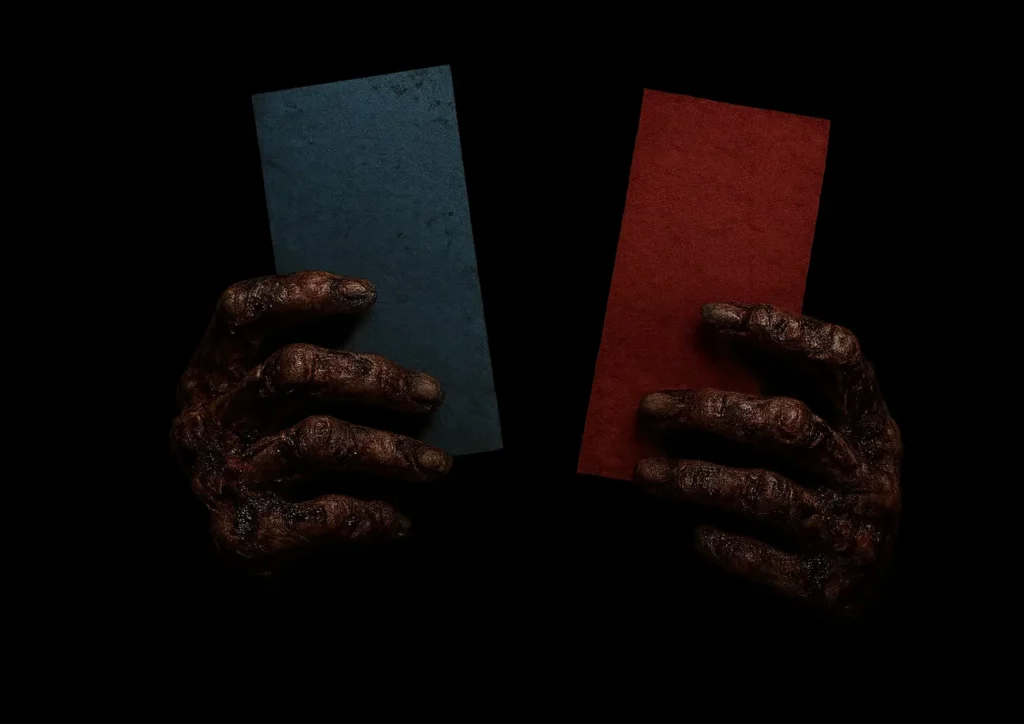
Aka Manto Powers and Abilities
Aka Manto is a dangerous demonic entity with terrifying supernatural powers, primarily tied to its ability to materialize in bathrooms and manipulate victims through psychological dread.
Compared to other yōkai, its strength lies in its inevitability rather than raw power. Aka Manto’s menace is psychological, trapping victims in a no-win scenario.
Its ability to appear suddenly and force a fatal choice makes it a formidable urban yūrei. However, its scope is limited to specific settings, unlike the wide-ranging kitsune or yamauba.
Aka Manto’s powers and abilities include:
- Materialization: Aka Manto can appear instantly in secluded restrooms—often the last stall—targeting lone individuals.
- Choice Manipulation: Presents a deadly choice (red or blue cloak/paper), with red causing flaying or blood-drenching and blue leading to strangulation or suffocation.
- Psychological Intimidation: Uses its eerie presence and voice to instill fear, paralyzing victims into making a choice.
- Possible Shapeshifting: Some tales suggest it alters the color or form of its cloak (e.g., red to blue) to suit the narrative of the trap.
- Teleportation: Implied ability to vanish or move between stalls, preventing easy escape.
How to Defend Against Aka Manto
To defend against the Aka Manto, it’s important to be clever and understand its specific rules.
According to stories, one of the best ways to avoid its tricks is to stay silent when it asks you a question—this can frustrate the spirit and may even make it disappear, as shown in tales like “The Silent Escape.” Another strategy is to leave the bathroom quickly before it can engage with you, but this can be tricky since Aka Manto appears quite suddenly.
Some newer stories suggest outsmarting Aka Manto by giving an unexpected answer, like saying “yellow” instead of choosing between red or blue, which seems to confuse it. However, this technique doesn’t always work.
Unlike other spirits that can be driven away with charms or salt, Aka Manto has no known weakness to physical objects, as it originates from urban legend.
Aka Manto vs Other Yōkai
| Name | Category of Yōkai | Origin | Threat Level | Escape Difficulty |
|---|---|---|---|---|
| Hanako-san | Yūrei | Spirit of a young girl who died in a school bathroom | Moderate: Haunts specific stalls but less lethal than Aka Manto | Low: Can often be avoided by not entering haunted stalls or using specific phrases |
| Kappa | Yōkai | Water spirit born from river deities | High: Drowns victims or steals organs | Moderate: Repelled by politeness, offerings, or draining its head-water |
| Tengu | Yōkai | Mountain spirit, once a monk or warrior | High: Kidnaps or manipulates humans | High: Requires spiritual knowledge or Shinto rituals to evade |
| Yuki-onna | Yūrei | Spirit of a woman who froze to death | High: Freezes victims with a glance | Moderate: Avoid eye contact or warm environments |
| Kitsune | Yōkai | Fox spirit tied to Inari shrines | Variable: Benevolent or malevolent, can trick or curse | High: Shapeshifting makes evasion difficult without offerings |
| Oni | Oni | Demonic creature, often a punished soul | Very High: Physically powerful, devours humans | High: Requires powerful talismans or divine intervention |
| Rokurokubi | Yōkai | Cursed human with an extending neck | Low: More mischievous than deadly | Low: Avoid nighttime encounters or recognize their human form |
| Nure-onna | Yōkai | Sea serpent with a woman’s head | High: Drowns men near coasts | Moderate: Avoid coastal waters or use protective charms |
| Kuchisake-onna | Yūrei | Vengeful spirit of a mutilated woman | High: Kills with a yes/no question | Moderate: Confuse with ambiguous answers or offerings |
| Yamauba | Yōkai | Mountain hag, often a corrupted woman | High: Eats humans, lures with deception | High: Knowledge of her habits or offerings needed |
| Gashadokuro | Yūrei | Giant skeleton of unburied soldiers | Very High: Crushes or devours victims | Very High: Nearly impossible to escape once targeted |
| Noppera-bō | Yōkai | Faceless spirit, often a shapeshifter | Low: Scares but rarely harms | Low: Flee or ignore to avoid psychological fear |
| Tsuchigumo | Yōkai | Earth spider, born from cursed warriors | High: Traps victims in webs | Moderate: Avoid caves or use fire-based defenses |
| Kasa-obake | Tsukumogami | Sentient umbrella after 100 years | Low: Mischievous, rarely harmful | Low: Easily avoided by not interacting with old objects |
| Zashiki-warashi | Yōkai | Child spirit tied to households | Low: Benevolent, brings luck | None: Not a threat, no need to escape |
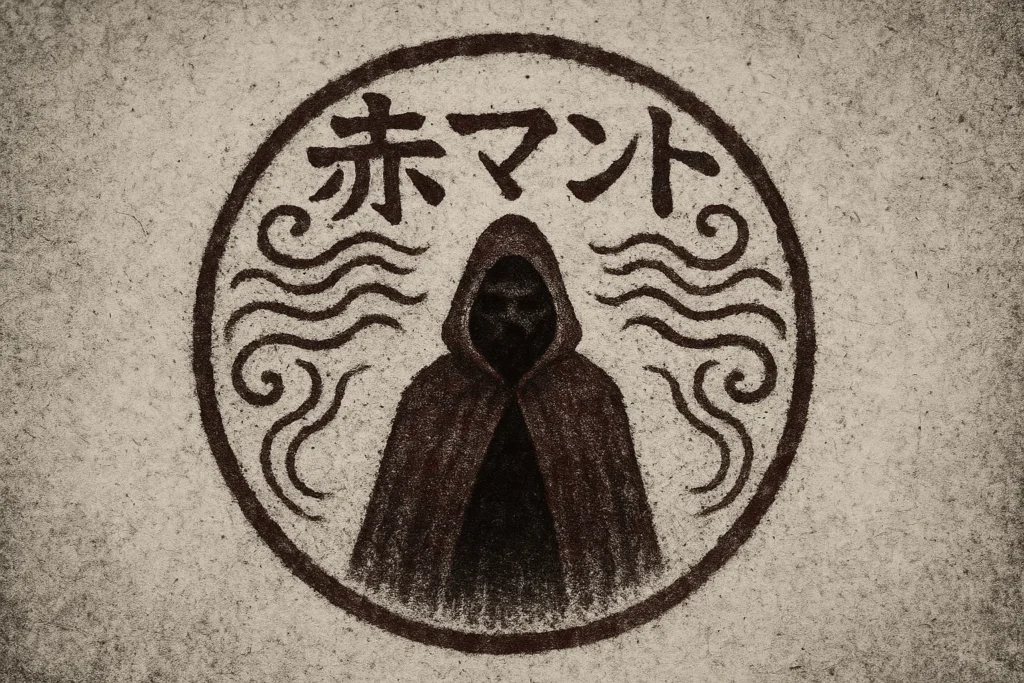
Symbolism
| Attribute | Details |
|---|---|
| Element | Air: Tied to the unseen, fleeting presence in confined bathroom spaces |
| Animal | None: No animal association, as Aka Manto is humanoid and urban |
| Cardinal Direction | West: Linked to urban settings and evening encounters, tied to Onmyōdō’s association of west with ghosts |
| Color | Red: Symbolizes blood, danger, and sacrifice; blue variants represent death by suffocation |
| Plant | None: No specific plant tied to urban Aka Manto lore |
| Season | Autumn: Often associated with school terms and evening encounters |
| Symbolic Item | Red/Blue Cloak: Represents the fatal choice and duality of death |
Aka Manto symbolizes our fears of making irreversible decisions and of feeling vulnerable in private spaces, such as bathrooms. In Japan, stories about Aka Manto often revolve around school bathrooms, tapping into children’s anxieties about being alone and the warnings peers share about encountering this spirit.
This yōkai is often depicted in striking red and blue. Red symbolizes blood and sacrifice, while blue represents the coldness of death, reflecting the life-and-death choices people may face.
You may also enjoy:
Mahakala: The Dark Guardian Who Consumes Evil
October 16, 2025
Mara: The Buddhist Demon King of Desire and Death
October 13, 2025
Who Is Adrammelech in Demonology and the Bible?
October 1, 2025
Who Is Taṇhā, the Seductive Demon of Craving in Buddhist Mythology?
October 15, 2025
The Ghul: The Flesh-Eating Demon of Arabian Folklore
October 1, 2025
Aamon: The Infernal Marquis of Lust, Feuds, and False Prophecies
September 29, 2025
Frequently Asked Questions
What does Aka Manto do to you?
Aka Manto confronts you in a restroom’s last stall, asking if you want red or blue paper; choosing red leads to being slashed or flayed, leaving your body soaked in blood, while blue results in strangulation until your face turns blue, symbolizing ritualistic death. In folklore, the yōkai exploits solitude, with no choice sparing you unless you refuse to answer or flee.
Are Atsushi and Aka Manto the same?
Atsushi and Aka Manto are not the same; in Chilla’s Art’s Aka Manto game, Atsushi is a character linked to the yōkai’s lore, possibly a human tied to its origin story, like a bullied student whose death birthed the spirit. At the same time, Aka Manto is the supernatural entity itself.
How do you summon Aka Manto?
Folklore does not describe a deliberate summoning ritual for Aka Manto, as it appears unbidden in women’s restrooms, particularly the last stall, targeting lone individuals without provocation. Unlike urban legends with summoning rites (e.g., Bloody Mary’s mirror chants), Aka Manto’s encounters are spontaneous, tied to solitude or paper scarcity in 1930s tales.
Is Aka Manto a true story?
Aka Manto is not a true story but a fictional urban legend from 1930s Japan, born from schoolyard tales with no historical or documented encounters beyond oral folklore. Its bathroom hauntings reflect cultural fears of urban isolation and gendered vulnerability, amplified by media like horror manga, not real events.
Can you survive Aka Manto?
Yes, surviving Aka Manto is possible in folklore by refusing to choose red or blue paper—saying “no paper,” staying silent, or demanding a third color like “yellow” can confuse the yōkai, causing it to vanish. Fleeing the stall before answering also works in some tales, though its sudden appearance complicates this.
Can Aka Manto teleport?
Aka Manto is implied to have teleportation-like abilities in folklore, as it materializes instantly in the last restroom stall and vanishes when thwarted, suggesting supernatural movement within confined spaces. While not explicitly described as teleporting, its ability to appear and disappear without a trace, as seen in 1930s tales and modern games, aligns with yūrei traits of ethereal travel.
